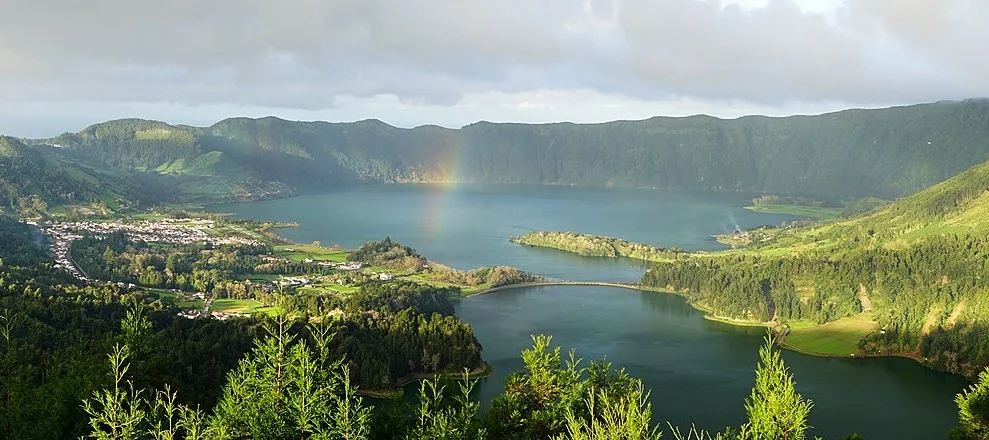The Sete Cidades Massif is a stratovolcanic complex belonging to a polygenetic volcano and caldera, located in the western part of the São Miguel Island, in the Portuguese archipelago of the Azores.
 |
| Sete Cidades Azores |
More recognizable by the Lagoa das Sete Cidades at its center, this volcanic complex includes centuries of geomorphological structures including lava domes, cones, lava flows, and Maar geomorphology that have marked its history.
History
Sete Cidades massif with small radial cones in Santo António.
The nearly circular caldera is a nested structure resulting from three separate caldera collapse episodes, each associated with explosive eruptions. These episodes of caldera collapse occurred after explosive eruptions that formed the pyroclastic fields of Risco, Brittany and Santa Barbara.
The first phase took place 35,700 years ago and ended with the collapse of the main volcano. The secondary phase began about 28,750 years ago and was responsible for the collapse of the northwestern part of the primitive caldera. About 15 740 years ago, the last phase occurred, marked by the collapse of the northern and northeastern parts of the crater. In each of these phases of the formation lapillian deposition (as a result of Plinian eruptions ) and pyroclastic flow deposits were transformed into ignimbrites by melting.
 |
| Sete Cidades Azores |
Over the past 5000 years, 17 intracaldera eruptions have occurred on the Sete Cidades massif, making it the most active in the archipelago. Within the calderan, activity has been markedly marked by trachyte of sub- Plinian and Plinian eruptions, with some hydromagmatic characteristics. These formations date back to 35,700 BC, 28,750 BC. and 15 740 BC.
Numerous smaller explosive eruptions occurred between these paroxysmal events. Over the past 5000 years, there have been 17 explosive eruptions of the Sete Cidades volcano, which led to precipitation and hydromagmatic eruptions.The location of these eruptions varies, but they mostly spread southward. However, there is geological evidence for pyroclastic density currents associated with three or four explosive events, but high concentrations of pyroclastic flows are rare. It is likely that:
any pyroclastic flows were limited by channels and only locally deposited in depressions; and
these deposits were quickly washed away.
 |
| Sete Cidades Azores |
The last intracaldera eruption occurred about 500 AD, which led to the formation of the Caldeira Seca cone. There are six Holocene pyroclastic cones at the base of the caldera. In addition, a large group of Pleistocene post-caldera trachytic lava domes, lava flows, and pyroclastic flow deposits were discovered on the northwestern slopes of the massif.
Historically, eruptions have generally been basaltic in quality, with effusive characteristics that were less explosive, but mostly Hawaiian or Strombolian in nature, occurring along crater flanks and caused by regional and radial faults. Unlike Furnas, there are no active fumaroles in Sete Cidades, and most of the secondary manifestations occur in underwater vents off the coast of Ponta da Ferraria and the coast of Mosteiros, as well as in natural degassing zones.
The most recent historical eruption dates back to the 15th century; Sete Cidades has not historically erupted, although an eruption may have occurred just before the first colonization of the island, associated with the rift zone immediately southeast of the Sete Cidades massif. Other eruptions occurred in the caldera and from underwater vents along the west coast of the island; in the history of the occupied territories there have been four Strombolian eruptions and three Surcean eruptions a short distance from the coastline.
Geography
The Sete Cidades massif occupies the northwestern part of the island and corresponds to a circular central caldera 6 by 5 kilometers (3.7 × 3.1 miles), the interior of which is occupied by various lakes and volcanic pumice cones, lava domes and maars. Caldera depth ranges from 200 meters (660 feet) in the west to 500 meters (1600 feet) in the east, although it averages around 300 meters (980 feet).
 |
| Sete Cidades Azores |
Regional tectonics affects the geomorphological forms in this region, as does the rift zone, characterized by numerous cinder cones extending southeast of the caldera. This fault zone is unusually 200 meters (660 ft) above the rim of the crater, which could protect Ponta Delgada from all but pyrcolastic flows associated with any future eruption. The northwest flank is marked by the Graben Mosheiros, a tectonic structure oriented northwest to southeast after the Terceira rift zone fractured. These faults and regional fractures gave way to radial faults, resulting in cinder cones and lava domes throughout the Serres.
Sete Cidades volcano is distinguished by two stratigraphic layers:
The lower group includes the oldest deposits associated with subaerial eruptions that occurred over 200,000 BC. This period of activity was mainly effusive, producing basaltic trachyte lava flows.
The upper layer includes the products of the eruption that occurred 36,000 BC, which led to the first formation of the primary monogenic cone. This group is marked by six phases of formation from explosive debris of trachytic materials, including pyroclastic bombs and flows, some of which are the result of hydromagmatic forces.
